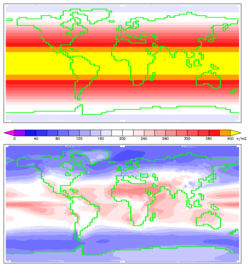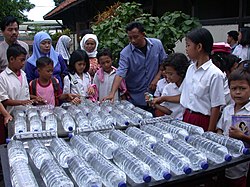Solar energy
Solar energy is a type of energy that comes from the sun's heat. People have been using solar energy for thousands of years in different ways, such as heating, cooking, and drying. Nowadays, it is also used to create electricity in areas where other sources of power are not available, such as remote locations and even outer space.
The cost of generating electricity from solar energy is decreasing, making it a more affordable option. Since the sun provides heat and light constantly, solar energy is considered a renewable energy source and an alternative to non-renewable resources like coal and oil.
Energy uses
Solar energy is used in various ways today, including:
- As a source of heat for making hot water, heating buildings and cooking
- To generate electricity through the use of solar cells or heat engines
- To take the salt away from sea water, making it drinkable.
- To use sun rays for drying clothes and towels.
- It is used by plants for the process of photosynthesis.
- To use in cooking (Solar cookers).
Energy from the Sun
After passing through the Earth's atmosphere, most of the Sun's energy is in the form of visible light and infrared light radiation. Plants convert the energy in sunlight into chemical energy (sugars and starches) through the process of photosynthesis. Humans regularly use this store of energy in various ways, as when they burn wood off fossil fuels, or when simply eating plants, fish and animals.
Solar radiation reaches the Earth's upper atmosphere with the power of 1366 watts per square meter (W/m2). Since the Earth is round, the surface nearer its poles is angled away from the Sun and receives much less solar energy than the surface nearer the equator.
At present, solar cell panels convert, at best, about 15% of the sunlight hitting them into electricity.[1] The dark disks in the third diagram on the right are imaginary examples of the amount of land that, if covered with 8% efficient solar panels, would produce slightly more energy in the form of electricity than the world needed in 2003. [2]
Types of technologies

Many technologies have been developed to make use of solar radiation. Some of these technologies make direct use of the solar energy (e.g. to provide light, heat, etc.), while others produce electricity.[3]
Solar power plants
Solar power plants convert sunlight into electricity, either directly using photovoltaics (PV), or indirectly using concentrated solar power (CSP). Concentrated solar power systems use lenses or mirrors and tracking systems to focus a large area of sunlight into a small beam. Photovoltaics converts light into electric current using the photoelectric effect.[4]
Photovoltaics
| Photovoltaic power station | Country | Site co-ordinates | Nominal power |
Production (Annual GW·h) |
Notes and references |
|---|---|---|---|---|---|
| Topaz Solar Farm[5] | USA | 35°23′N 120°4′W / 35.383°N 120.067°W | 500 | installed capacity as of June 2019. | |
| Desert Sunlight Solar Farm | USA | 33°49′33″N 115°24′08″W / 33.82583°N 115.40222°W | 500 | Commissioned since November 2013 toward final capacity 550 MW | |
| Longyangxia Dam Solar Park[6] | China | 36°07′20″N 100°55′06″E / 36.12222°N 100.91833°E | 320 | Completed December 2013 | |
| Solar Star I and II[7] | USA | 309 | Under construction, 579MW when completed[8] | ||
| California Valley Solar Ranch[9] | USA | 35°20′N 119°55′W / 35.333°N 119.917°W | 292[10][11] | 399 | First 130MW connected 1 February 2013.[12] |
| Agua Caliente Solar Project[13] | USA | 32°57.2′N 113°29.4′W / 32.9533°N 113.4900°W | 290[14][15] | 626 | completed April 2014[16] |
| Antelope Valley Solar Ranch[13][17][18] | USA | 34°46′N 118°25′W / 34.767°N 118.417°W | 266[19] | 230 MWAC. Has received government loan guarantee |
Concentrated solar thermal
Rank
Solar cooker
Solar cooking uses the Sun as the source of energy instead of standard cooking fuels such as charcoal, coal or gas. Solar cookers are an inexpensive and environmentally sound alternative to traditional ovens. They are becoming widely used in areas of the developing world where deforestation is an issue, financial resources to purchase fuel are limited, and where open flames would pose a serious risk to people and the environment. Solar cookers are covered with a glass plate. They achieve a higher temperature by using mirrors to focus the rays of the sun.
Solar heater

The Sun may be used to heat water instead of electricity or gas. There are two basic types of active solar heating systems based on the type of fluid — either liquid or air — that is heated in the solar energy collectors. (The collector is the device in which a fluid is heated by the Sun.)
Liquid-based systems heat water or an antifreeze solution in a "hydronic" collector, whereas air-based systems heat air in an "air collector."[29] Both air and liquid systems can supplement forced air systems.
Solar cells
Solar cells can be used to generate electricity from sunlight. It is a device that converts light energy into electrical energy. Sometimes the term solar cell is reserved for devices intended specifically to capture energy from sunlight, while the term photovoltaic cell is used when the light source is unspecified.
Solar cells have many applications. They have long been used in situations where electrical power from the grid is unavailable, such as in remote area power systems, Earth-orbiting satellites and space probes, consumer systems, e.g. handheld calculators or wrist watches, remote radiotelephones and water pumping applications. A large no. of solar cells are combined in an arrangement called solar cell panel that can deliver enough electricity for practical use. Electricity produced by solar panels can be stored in rechargeable solar batteries, which is then drawn upon when required.[30]
Solar Energy Media
The Sun produces electromagnetic radiation that can be harnessed as useful energy.
Global map of horizontal irradiation
Solar water heaters facing the Sun to maximize gain
MIT's Solar House #1, built in 1939 in the US, used seasonal thermal energy storage for year-round heating.
Parabolic dish produces steam for cooking, in Auroville, India.
Solar water disinfection in Indonesia
Darmstadt University of Technology, Germany, won the 2007 Solar Decathlon in Washington, DC with this passive house designed for humid and hot subtropical climate.
Greenhouses like these in the Westland municipality of the Netherlands grow vegetables, fruits and flowers.
Related pages
References
- ↑ A solar panel in the contiguous United States on average delivers 19 to 56 W/m² or 0.45 - 1.35 (kW·h/m²)/day."us_pv_annual_may2004.jpg". National Renewable Energy Laboratory, US. Retrieved 2006-09-04.
- ↑ International Energy Agency - Homepage
- ↑ "Solar energy powered lights".
- ↑ "Technologies: From silicon to the solar cell". Archived from the original on 2011-07-19. Retrieved 2011-03-21.
- ↑ "The Tribune: California Valley's Topaz Solar Farm now producing electricity". Archived from the original on 2015-03-03. Retrieved 2014-07-08.
- ↑ "SolarServer: CPI completes massive hybrid solar PV/hydro plant in Western China". Archived from the original on 2014-12-17. Retrieved 2014-11-09.
- ↑ Solar Star Project, Japan DG Demand Drive SunPower's Q3, Forbes, 10/31/2014
- ↑ "Solar Star I & II Solar". Archived from the original on 2014-12-14. Retrieved 2014-11-09.
- ↑ Energy Division Resolution E-4229
- ↑ U.S. Solar Market Trends 2013 Archived 2014-10-21 at the Wayback Machine, IREC, July 2014
- ↑ Meza, Edgar (27 June 2013). NRG Energy completes 250 MW California Valley Solar Ranch. Solar Energy Industry Association. http://www.seia.org/news/nrg-energy-completes-250-mw-california-valley-solar-ranch. Retrieved 5 July 2013.
- ↑ "130MW energized". California Valley Solar Ranch. Retrieved 1 February 2013.
- ↑ 13.0 13.1 "RPS Project Status Table - February Update". Archived from the original on 2012-07-23. Retrieved 2014-11-09.
- ↑ "World's Largest Operational Solar PV Project, Agua Caliente, Achieves 250 Megawatts of Grid-Connected Power". Archived from the original on 2013-05-01. Retrieved 2014-11-09.
- ↑ "First Solar Stops Installation at Agua Caliente Project". Bloomberg. https://www.bloomberg.com/news/2012-08-30/first-solar-stops-installation-at-agua-caliente-project.html.
- ↑ World’s Biggest Solar PV Plant a Feather in DOE’s Cap, Pete Danko, greentechmedia, May 2, 2014
- ↑ "AV Solar Ranch One". NextLight Renewable Power LLC. 2009. Archived from the original on 2009-10-17. Retrieved 2009-06-06.
- ↑ Project Overview
- ↑ Hill, Joshua (22 Feb 2013). Antelope Valley Solar Ranch One Achieves 100 Megawatt Milestone. http://cleantechnica.com/2013/02/22/antelope-valley-solar-ranch-one-achieves-100-megawatt-milestone/. Retrieved 1 February 2013.
- ↑ Ivanpah Solar Electric Generating System, retrieved 2014-02-18
- ↑ SEGS Power Stations, retrieved 2010-03-20
- ↑ "Abengoa Solar: Abengoa's Solana, the US's first large-scale solar plant with thermal energy storage system, begins commercial operation". Archived from the original on 2014-12-16. Retrieved 2014-07-08.
- ↑ "CSP World". Archived from the original on 2014-04-04. Retrieved 2014-07-08.
- ↑ Andasol Solar Power Station, archived from the original on 2013-09-28, retrieved 2010-03-20
- ↑ Andasol Solar Power Station, archived from the original on 2018-04-24, retrieved 2010-03-20
- ↑ 26.0 26.1 26.2 26.3 (in Spanish) Lokalizacion de Centrales Termosolares en Espana Archived 2013-03-10 at the Wayback Machine
- ↑ "ACS LAUNCHES THE OPERATION PHASE OF ITS THIRD DISPATCHABLE 50 MW THERMAL POWER PLANT IN SPAIN, EXTRESOL-1" (PDF). Archived from the original (PDF) on 2011-07-20. Retrieved 2014-07-08.
- ↑ "VALLE 1 and VALLE 2". Archived from the original on 2009-09-03. Retrieved 2014-07-08.
- ↑ "Active Solar Heating". Archived from the original on 2011-03-16. Retrieved 2011-03-21.
- ↑ "Solar Batteries | Natural Solar" (in en-US). Natural Solar. https://naturalsolar.com.au/solar-batteries/. Retrieved 2018-11-01.
Other websites
- Solar Energy Industries Association is the national trade association for the US solar energy industry and has information on current commercial technologies and market developments.
- Direct solar U.S. Department of Energy: Energy Efficiency and Renewable Energy - Thermal water splitting
- U.S. Department of Energy: Energy Efficiency and Renewable Energy Solar History Timeline
- National Renewable Energy Laboratory: Concentrating Solar Power (CSP)
- Solar energy in the News
Archived 2020-10-29 at the Wayback Machine
- ESTIF - European Solar Thermal Industry organization (statistics, market situation)
- Solar perspectives in Italy Archived 2017-09-18 at the Wayback Machine - Information on the Italian Solar Market
- Online article by scientist Jonathan G. Dorn, July 22-2008 Archived 2008-08-10 at the Wayback Machine The solar thermal power industry experienced a surge in 2007, with 100 megawatts of new capacity worldwide.














